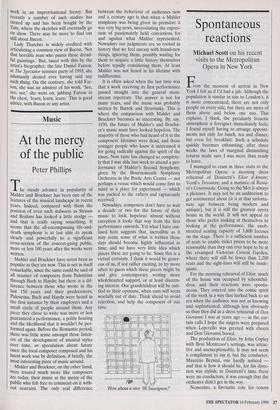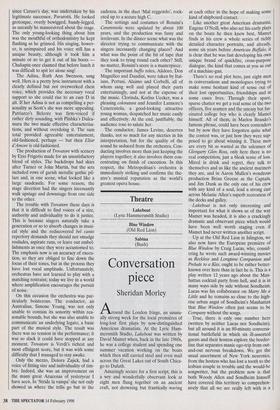Spontaneous reactions
Michael Scott on his recent visits to the Metropolitan Opera in New York From the moment of arrival in New York I felt as if I'd had a jab. Although the population is similar in size to London's, it is more concentrated; there are not only people on every side, but there are more of them above and below one too. This explains, I think, the peculiarly frenetic atmosphere a foreigner immediately feels; I found myself having to arrange appoint- ments not only for lunch, tea and dinner, but even for breakfast. Such a schedule quickly becomes exhausting; after three weeks the laws of marginal diminishing returns made sure I was more than ready to leave.
I managed to cram in three visits to the Metropolitan Opera: a morning dress rehearsal of Donizetti's Elisir d'Amore; Verdi's Trovatore; and a matinee of Rossi- ni's Cenerentola. Going to the Met is always a pleasure. It may not be an auditorium to get sentimental about (it is at that unfortu- nate age between being modern and antique), but it is still the greatest opera house in the world. It will not appeal to those who prefer looking at themselves to looking at the performance: the unob- structed seating capacity of 3,800 focuses on the stage. There is a sufficient number of seats to enable ticket prices to be more reasonable than they can ever hope to be at the revamped Victorian Covent Garden, where there will still be fewer than 2,200 seats and the sight-lines will still be inade- quate.
For the morning rehearsal of Elisir, much of the house was occupied by schoolchil- dren, and their reactions were sponta- neous. They entered into the comic spirit of the work in a way that harked back to an era when the audience was not as knowing and sophisticated; although less obviously so than they did at a dress rehearsal of Don Giovanni I was at years ago — in the cur- tain calls I hope the singers were prepared when Leperello was greeted with cheers and Don Giovanni booed.
The production of Elisir, by John Copley with Beni Montresor's settings, was attrac- tive and unexceptionable. It may not seem a compliment to say it, but the conductor, Maurizio Bernini, one hardly noticed and that is how it should be, for his direc- tion was stylish; in Donizetti's time there were no conductors, it was enough that the orchestra didn't get in the way.
Nemorino, a favourite role for tenors since Caruso's day, was undertaken by his legitimate successor, Pavarotti. He looked grotesque, overly bewigged, bandy-legged, as uneasily he manoeuvred about the stage. The only young-looking thing about him was the mouthful of orthodontistry he kept flashing as he grinned. His singing, howev- er, is unimpaired and his voice still has a unique beauty, although it took him a minute or so to get it out of his boots — Chaliapin once claimed that before lunch it was difficult to spit let alone sing!
The Adina, Ruth Ann Swenson, sang well. Hers is a pretty lyric instrument with a clearly defined but not overworked chest voice, which provides the necessary vocal support so she could rise to an easy D in alt. If her Adina is not as compelling a per- sonality as Scott's she was more appealing. Patriarco's Belcore was firm-voiced if rather dirty sounding, with Plishka's Dulca- mara the two made effective characterisa- tions, and without overdoing it. The sum total provided agreeable entertainment, old-fashioned, perhaps — but then Elisir d'Amore is old-fashioned.
The production of Trovatore with scenery by Ezio Frigerio made for an unsatisfactory blend of styles. The backdrops had skies after Turner or John Martin, but the sets included rows of garish metallic gothic pil- lars and, in one scene, what looked like a large sandcastle. For some reason, the stage direction had the singers incessantly walk upstage and downstage from one side to the other.
The trouble with Trovatore these days is that it is difficult to find voices of a size, authority and individuality to do it justice. This is because singers naturally take a generation or so to absorb changes in musi- cal style and the rediscovered bel canto repertory demands they should not smudge roulades, aspirate runs, or leave out embel- lishments as once they were accustomed to. The emphasis now is on accuracy of execu- tion, so they are obliged to fine down the focus of their tones, but in the process they have lost vocal amplitude. Unfortunately, orchestras have not learned to play with a matching restraint; today we live in a world where amplification encourages the pursuit of noise.
On this occasion the orchestra was par- ticularly boisterous. The conductor, an Australian, Simone Young, was not only unable to contain its sonority within rea- sonable bounds, but she was also unable to communicate an underlying legato, a basic part of the musical style. The result was there was no tension in the performance; it was so slack it could have stopped at any moment. Trovatore is Verdi's richest and most effulgent score, but it was with some difficulty that I managed to stay awake.
Only the mezzo, Dolora Zajick, had a voice of fitting size and individuality of tim- bre. Indeed, she was an improvement on the many great Azucenas of yesteryear I have seen. In 'Stride la vampa' she not only showed us where the trills go but in the cadenza, in the duet 'Mal reggendo', rock- eted up to a secure high C.
The settings and costumes of Rossini's Cenerentola were updated by about 100 years, and the production was fussy and irrelevant. In the dinner scene what was the director trying to communicate with the singers incessantly changing places? And what was the point of the bit of tape that they took to tying round each other? Still, no matter, Rossini's score is a masterpiece.
The important buffo roles, Alidoro, Don Magnifico and Dandini, were taken by Ital- ians, Pertusi, Alaimo and Corbelli, all of whom sang well and played their parts entertainingly, and not at the expense of the music. Clorinda, Korliss Uecker, was a pleasing coloratura and Jennifer Larmore's Cenerentola, a good-looking attractive young woman, despatched her music easily and effectively. At the end, justifiably, the audience rose to salute her.
The conductor, James Levine, deserves thanks, not so much for any niceties in his interpretation, but for the quality of the sound he seduced from the orchestra. Con- ducting involves more than just keeping the players together; it also involves them con- centrating on finish of execution. In this respect, the Metropolitan's orchestra is immediately striking and confirms the the- atre's musical reputation as the world's greatest opera house.


























































 Previous page
Previous page